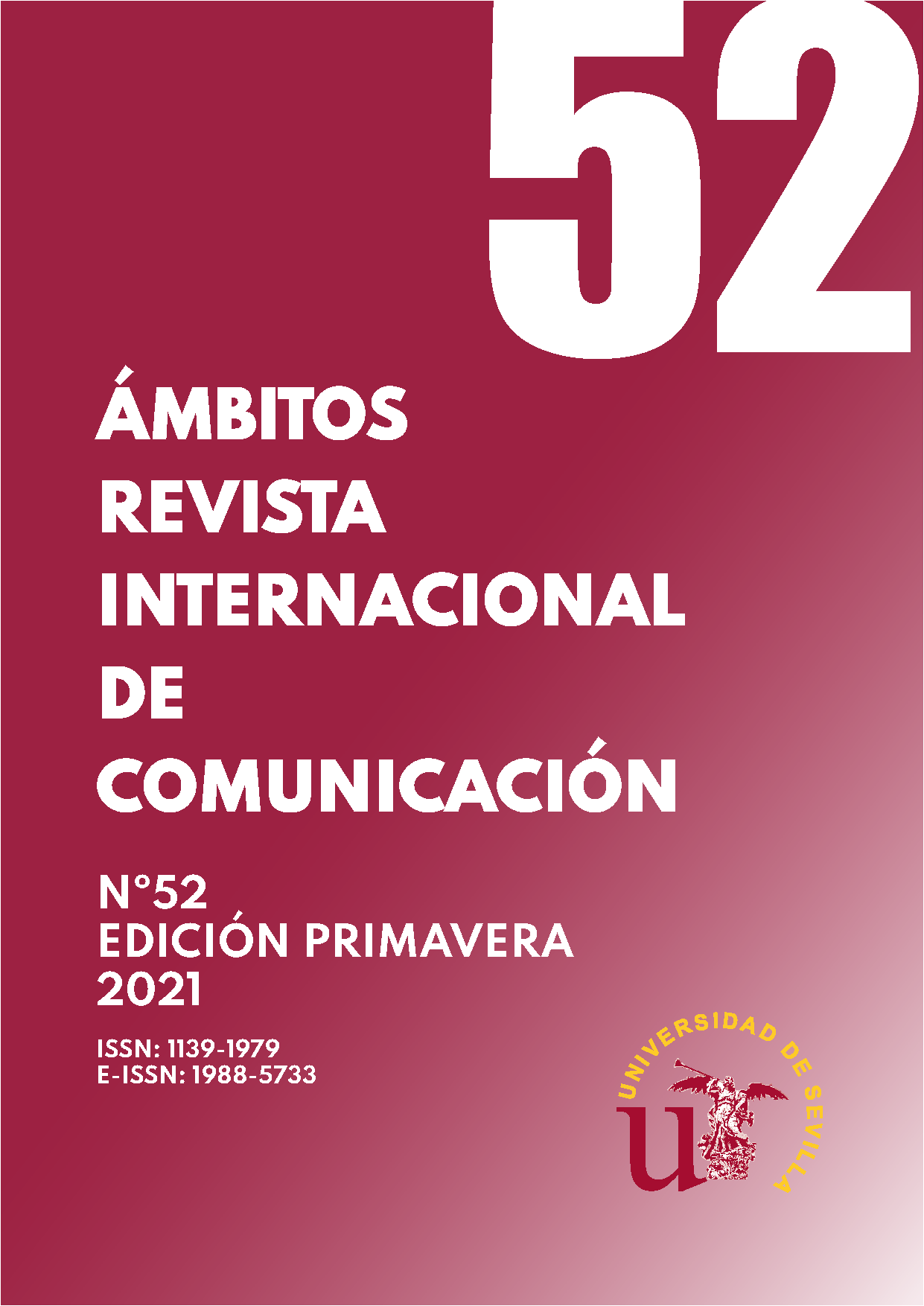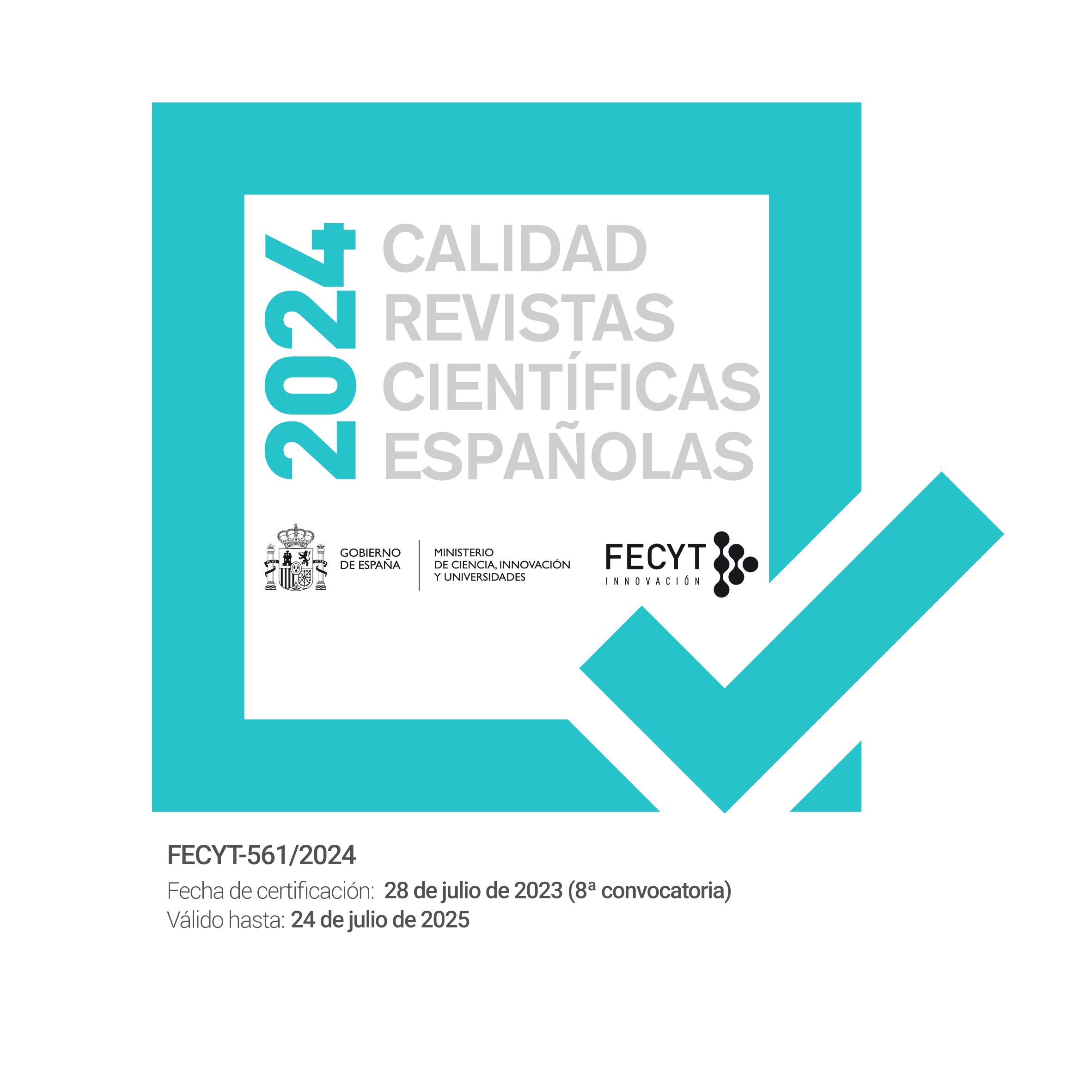Institutional crisis communication and social networks in the Covid-19: the cases of Yunquera and Gaucín
DOI:
https://doi.org/10.12795/Ambitos.2021.i52.07Keywords:
institutional communication, crisis communication, social networks, Covid-19, town hallAbstract
Digital channels and social networks are tools at the service of institutional communication both to establish relations with the public and to inform and legitimise the policies implemented. Their use has spread to the local sphere and it is common for even small municipalities to have social profiles, which have been a key tool during the Covid-19 crisis to convey messages to the population.
This research consists of a case study focusing on the institutional use of Facebook in the Malaga municipalities of Yunquera and Gaucín, both of which have fewer than 3,000 inhabitants, and where this social network has stood out for its effectiveness. Using a mixed methodology, it combines in-depth interviews with councillors, content analysis of social profiles and monitoring of publications during the pandemic. Facebook has greatly facilitated the dissemination of relevant information for the residents and has become the priority digital channel for both councils. New content has also been incorporated, such as the municipal sides. The transfer of these municipalities’ own communications to social networks and their combined use with the personal profiles of mayors, which have been predominant, has been fundamental in the success of their digital communications during the pandemic. Recommendations are included for the management of digital communication during the new normality in town halls.
This research consists of a case study focusing on the institutional use of Facebook in the Malaga municipalities of Yunquera and Gaucín, both of which have fewer than 3,000 inhabitants, and where it has proved highly effective. Using a mixed methodology, it combines in-depth interviews with councillors, content analysis of social profiles and monitoring of publications during the pandemic. Facebook has greatly facilitated the dissemination of relevant information for the residents and has become the priority digital channel for both councils. New content has also been incorporated, such as the municipal sides. The transfer of these municipalities' own communications to social networks and their combined use with the personal profiles of mayors, which have been predominant, has been fundamental in the success of their digital communications during the pandemic. Recommendations are included for the management of digital communication during the new normality in town halls
Downloads
Metrics
References
Allahverdipour H. (2020). Global Challenge of Health Communication: Infodemia in the Coronavirus Disease (COVID-19) Pandemic. J Educ Community Health,7(2), 65-67. Recuperado de http://jech.umsha.ac.ir/article-1-1000-en.html
Almada, A. A. (2009). Marketing de crisis. Herramientas concretas para afrontar la actual crisis económica. Madrid: Pirámide.
Almansa, A. (2006). Gabinetes de comunicación. Estudio sobre su presencia en las organizaciones, Anàlisi: quaderns de comunicació i cultura, (34), 223-237. Recuperado de https://www.raco.cat/index.php/Analisi/article/view/55454
Almansa, A. & Castillo–Esparcia, A. (2014). Comunicación Institucional en España. Estudio del uso que los diputados españoles hacen de las TIC en sus relaciones con la ciudadanía. Chasqui Revista Latinoamericana de Comunicación, 26. Recuperado de https://revistachasqui.org/index. php/chasqui/article/view/250/694
Apuke, O. D., & Omar, B. (2021). Fake news and COVID-19: modelling the predictors of fake news sharing among social media users. Telematics and Informatics, 56, 101475. https://doi.org/10.1016/j.tele.2020.101475
Barquero, J. D. & Barquero, M. (2005). Manual de Relaciones Públicas, Comunicación y Publicidad. Barcelona: Editorial Gestión 2000.
Berganza, R. & Ruiz San Román, J. A. (2005). Investigar en comunicación. Madrid: McGraw Hill.
Bernhard, U. & Dohle, M. (2015) Local Politics Online: The Influence of Presumed Influence on Local Politicians’ Online Communication Activities in Germany, Local Government Studies, 41(5), 755-773, https://doi.org/10.1080/03003930.2015.1028624
Boulianne, S. (2015). Social media use and participation: A meta-analysis of current research. Information, communication & society, 18(5), 524-538. https://doi.org/10.1080/1369118X.2015.1008542
Cabero, J., y Ruiz-Palmero, J. (2018). Las Tecnologías de la información y la comunicación para la inclusión: reformulando la brecha digital, International Journal of Educational Research and Innovation (IJERI), 9, 16-30, http://hdl.handle.net/11441/66918
Calderón Gómez, D. (2019). Una aproximación a la evolución de la brecha digital entre la población joven en España (2006-2015). RES. Revista Española de Sociología, 28(1), 27-44. http://dx.doi.org/10.22325/fes/res.2018.16)
Campillo Alhama, C. (2011). La dirección de comunicación municipal: estructuras, procesos y entidades declarantes, Revista Internacional de Relaciones Públicas, 1(2), 41-60. Recuperado de http://hdl.handle.net/10630/5027
Campillo Alhama, C. (2012). Investigación en comunicación municipal: estudios y aportaciones académicas, Vivat Academia, XIV(117E), 1035-1048. doi: http://dx.doi.org/10.15178/va.2011.117E.1035-1048
Cárdenas Rica, M. L. (1998). Profesionalización de los gabinetes de prensa municipales, Ámbitos Revista Internacional de Comunicación, 1, 131-141. Recuperado de http://hdl.handle.net/11441/67266
Carratalá, A. & Galán, M. (2016). Estrategias comunicativas en Twitter de los ayuntamientos españoles gobernados por plataformas ciudadanas, Revista F@ro, 2(24), 126-150.
Casero-Ripollés, A. (2020). Servicios móviles de mensajería instantánea y Covid-19: oportunidades y limitaciones para la comunicación institucional. Anuario ThinkEPI, 14, e14d05. https://doi.org/10.3145/thinkepi.2020.e14d05
Castillo-Esparcia, A. (2010). Introducción a las Relaciones Públicas. Málaga: Editorial Instituto de Investigación en Relaciones Públicas.
Castro-Martínez, A. (2019). Ciberdiplomacia y comunicación institucional: La presencia de la diplomacia digital española en redes sociales. Revista Estudios Institucionales, 6(10), 45-72. doi: https://doi.org/10.5944/eeii.vol.6.n.10.2019.23243
Català, Ll. & Penalva, C. (2020). El desarrollo del e-Gobierno en los pequeños municipios de la Comunidad Valenciana (España): más espejo que cristal. AGER: Revista de Estudios sobre Despoblación y Desarrollo Rural (Journal of Depopulation and Rural Development Studies), (29), 39-77. doi: https://doi.org/10.4422/ager.2020.02
Catalina García, B. & García Jiménez, A. (2013). Herramientas interactivas y participación ciudadana en los ayuntamientos españoles, Ámbitos Revista Internacional de Comunicación, 22, 1-19. doi: http://dx.doi.org/10.12795/Ambitos.2013.i22.15
Chan, A.K.M., Nickson, C.P., Rudolph, J.W., Lee, A. and Joynt, G.M. (2020), Social media for rapid knowledge dissemination: early experience from the COVID‐19 pandemic. Anaesthesia, 75, 1579-1582. https://doi.org/10.1111/anae.15057
Colombo, C. (2006). Innovación democrática y TIC,¿ hacia una democracia participativa?. IDP. Revista de Internet, Derecho y Política, (3), 28-40. Recuperado de https://dialnet.unirioja.es/servlet/articulo?codigo=2119691
Costa-Sánchez, C. & López-García, X. (2020). Comunicación y crisis del coronavirus en España. Primeras lecciones. El profesional de la información, 29(3), e290304. doi: https://doi.org/10.3145/epi.2020.may.04
Criado, J. I. & Rojas Martin, F. (2015). El impacto de las redes sociales digitales en las administraciones locales. Mitos y realidades en el caso español. IDP. Revista de Internet, Derecho y Política, (20),25-42 Recuperado de https://dialnet.unirioja.es/servlet/articulo?codigo=5582991
Criado, J. I. & Villodre, J. (2018). Comunicando datos masivos del sector público local en redes sociales. Análisis de sentimiento en Twitter. El profesional de la información, 27(3), 614-623. doi: https://doi.org/10.3145/epi.2018.may.14
De Sa, J., Mounier-Jack, S., & Coker, R. (2009). Risk communication and management in public health crises, Public health, 123(10), 643-644. doi: https://doi.org/10.1016/j.puhe.2009.07.017
Effing R., van Hillegersberg J., Huibers T.W.C. (2013) Social Media Participation and Local Politics: A Case Study of the Enschede Council in the Netherlands. In: Wimmer M.A., Tambouris E., Macintosh A. (eds) Electronic Participation. ePart 2013. Lecture Notes in Computer Science, vol 8075. Springer. https://doi.org/10.1007/978-3-642-40346-0_6
Faber, B., Budding, T., & Gradus, R. (2020). Assessing social media use in Dutch municipalities: Political, institutional, and socio-economic determinants. Government Information Quarterly, 37(3), 101484. doi: https://doi.org/10.1016/j.giq.2020.101484
Fernández-Falero, M. R., Trabadela-Robles, J., Garcés-Botacio, I., & Ruano-López, S. (2017). Comunicación política de los ayuntamientos a través de sus webs. Caso de Extremadura. El profesional de la información, 26(3), 404-410. doi: https://doi.org/10.3145/epi.2017.may.06
Feezell, J. T. (2018). Agenda Setting through Social Media: The Importance of Incidental News Exposure and Social Filtering in the Digital Era. Political Research Quarterly, 71(2), 482–494. https://doi.org/10.1177/1065912917744895
Gao, X. y Yu, J. (2020) Public governance mechanism in the prevention and control of the COVID-19: information, decision-making and execution, Journal of Chinese Governance, 5(2), 178-197, https://doi.org/10.1080/23812346.2020.1744922
Giacomini, D., Sancino, A. & Simonetto, A. (2018). The introduction of mandatory inter-municipal cooperation in small municipalities: Preliminary lessons from Italy, International Journal of Public Sector Management, 31(3), 331-346. doi: https://doi.org/10.1108/IJPSM-03-2017-0071
Gil de Zúñiga, H. y & Liu, J.H. (2017) Second Screening Politics in the Social Media Sphere: Advancing Research on Dual Screen Use in Political Communication with Evidence from 20 Countries, Journal of Broadcasting & Electronic Media, 61(2), 193-219, https://doi.org/10.1080/08838151.2017.1309420
Gil-García, J. R., & Pardo, T. A. (2005). E-government success factors: Mapping practical tools to theoretical foundations. Government information quarterly, 22(2), 187-216. https://doi.org/10.1016/j.giq.2005.02.001
Gupta, S., Nguyen, T. D., Rojas, F. L., Raman, S., Lee, B., Bento, A., ... & Wing, C. (2020). Tracking public and private responses to the COVID-19 epidemic: evidence from state and local government actions (No. w27027). National Bureau of Economic Research. DOI 10.3386/w27027
Gutiérrez-García, E. & La Porte, T. (2013). Tendencias emergentes en la comunicación de instituciones. Barcelona: UOC Press.
Hernández, R., Fernández, C., & Baptista P. (2010). Metodología de la Investigación. Distrito Federal de México: McGraw Hill.
Herrero-Gutiérrez, F. J., Martínez-Vallvey, F., Tapia-Frade, A., Rey-García, P., & Cabezuelo-Lorenzo, F. (2017). Transparencia en el sector público a través de salas de prensa online. Gestión de recursos colectivos y su información en webs municipales. El profesional de la información, 26(3), 421-429. doi: https://doi.org/10.3145/epi.2017.may.08
Herrero Gutiérrez, F. & Ruano López, S. (2019). Transparencia municipal y participación ciudadana en la democracia española. Estudio de caso: Comunidad de Madrid. Chasqui. Revista Latinoamericana de Comunicación, 0(139), 449-468. doi: https://doi.org/10.16921/chasqui.v0i139.3354
Hyun, K. D., & Kim, J. (2015). Differential and interactive influences on political participation by different types of news activities and political conversation through social media. Computers in Human Behavior, 45, 328-334. https://doi.org/10.1016/j.chb.2014.12.031.
Instituto Nacional de Estadística (2020). Malaga: población por municipios. INE. Recuperado de https://www.ine.es/jaxiT3/Datos.htm?t=2882#!tabs-tabla
Kantar (2020). COVID-19 Barometer: Consumer attitudes, media habits and expectations, Kantar. Recuperado de https://www.kantar.com/Inspiration/Coronavirus/COVID-19-Barometer-Consumer-attitudes-media-habits-and-expectations
Kimmons, R., Veletsianos, G. & Woodward, S. Institutional Uses of Twitter in U.S. Higher Education. Innov High Educ, 42, 97–111 (2017). doi: https://doi.org/10.1007/s10755-016-9375-6
Krzyżanowski, M., & Tucker, J. A. (2018). Re/constructing politics through social & online media: Discourses, ideologies, and mediated political practices. Journal of Language and Politics, 17(2), 141-154. https://doi.org/10.1075/jlp.18007.krz
Lammers, J.C & Barbour, J.B. (2006). An Institutional Theory of Organizational Communication, Communication Theory, 16(3), 356–377. doi: https://doi.org/10.1111/j.1468-2885.2006.00274.x
Laswad, F., Fisher, R., & Oyelere, P. (2005). Determinants of voluntary Internet financial reporting by local government authorities. Journal of accounting and public policy, 24(2), 101-121. https://doi.org/10.1016/j.jaccpubpol.2004.12.006
Lee, G., & Kwak, Y. H. (2012). An open government maturity model for social media-based public engagement. Government information quarterly, 29(4), 492-503. https://doi.org/10.1016/j.giq.2012.06.001
López-Tárraga, A. B. (2020). Comunicación de crisis y Ayuntamientos: el papel de Telegram durante la crisis sanitaria de la COVID-19, RAEIC, Revista de la Asociación Española de Investigación de la Comunicación, 7(14), 104-126. doi: https://doi.org/10.24137/raeic.7.14.5
López García, X. (2000). La comunicación del futuro se escribe con L de local, Ámbitos Revista Internacional de Comunicación, 5, 107-117. Recuperado de http://hdl.handle.net/11441/67340
Luecke, L. (2005). Gestión de crisis convertirlas en oportunidades. Barcelona: Ediciones Deusto.
March Cerdá, J. C. (2011). El riesgo de una mala comunicación de riesgos. Revista de Comunicación y Salud, 1(2), 61-66. doi: http://doi.org/10.35669/revistadecomunicacionysalud.2011.1(2).61-66
Martínez-Rolán, X., Piñeiro-Otero, T., & Baamonde-Silva, X. M. (2016). El desafío de la transparencia en la comunicación digital. Un estudio de caso sobre las webs municipales de Galicia y Norte de Portugal. Observatorio (OBS*), 10(4), 35-55. Recuperado de http://www.scielo.mec.pt/scielo.php?script=sci_arttext&pid=S1646-59542016000500003&lng=pt&tlng=es
Martínez-Valerio, L. (2012). Estrategias de promoción turística a través de Facebook. Palabra Clave, 15(2), 318-338. Recuperado de https://www.redalyc.org/articulo.oa?id=649/64923562006
Meneses, J. & Rodríguez, D. (2011). El cuestionario y la entrevista. Barcelona: UOC.
Mergel, I. & Bretschneider, S. I. (2013). A three-stage adoption process for social media use in government. Public Administration Review, 3, 390-400. doi: https://doi.org/10.1111/puar.12021
Mesa-Medina, Ó. & Marfil-Carmona, R. (2018). Diseño y propuesta de un modelo de análisis para la gestión de la comunicación corporativa local. Ámbitos. Revista Internacional de Comunicación, 3(42), 18-39. doi: http://dx.doi.org/10.12795/Ambitos.2018.i42.02
Micaletto Belda, J. (2018). Principios fundamentales de la comunicación en crisis: una configuración táctica. Razón Y Palabra, 22(2_101), 503-517. Recuperado de http://www.revistarazonypalabra.org/index.php/ryp/article/view/1079
Molina, A., Fernández, A. C., Gómez, M., & Aranda, E. (2017). Differences in the city branding of European capitals based on online vs. offline sources of information. Tourism Management, 58, 28-39. doi: https://doi.org/10.1016/j.tourman.2016.10.005
Olabe, F. M. & Márquez López. J. A. (2019). Integración de Twitter y Facebook en la comunicación de la administración local: el Ayuntamiento de Elche como caso de estudio, Miguel Hernández Communication Journal, 10(1), 57-81. doi: http://dx.doi.org/10.21134/mhcj.v10i0.275
Orso, D., Federici, N., Copetti, R., Vetrugno, L., & Bove, T. (2020). Infodemic and the spread of fake news in the COVID-19-era. European journal of emergency medicine : official journal of the European Society for Emergency Medicine, 27(5), 327–328. https://doi.org/10.1097/MEJ.0000000000000713
Padilla Castillo, G. (2016). Redes sociales institucionales de éxito: los casos de @policia y @guardiacivil en España. Opción: Revista de Ciencias Humanas y Sociales, (12), 85-109. Recuperado de https://dialnet.unirioja.es/descarga/articulo/5852298.pdf
Paricio-Esteban, P., Bruno-Carlos, T., Alonso-Romero, E., & García-Alcober, M. P. (2020). Webs y portales de transparencia para la participación ciudadana en la gestión de las relaciones públicas con los stakeholders locales. Profesional de la información, 29(3), e290335. doi: https://doi.org/10.3145/epi.2020.may.35
Pérez-Dasilva, J. A., Meso-Ayerdi, K. & Mendiguren-Galdospín, T. (2020). Fake news y coronavirus: detección de los principales actores y tendencias a través del análisis de las conversaciones en Twitter. El profesional de la información, 29(3), e290308. doi: https://doi.org/10.3145/epi.2020.may.08
Rebollo, M. Á. & Vico, A. (2014). El apoyo social percibido como factor de la inclusión digital de las mujeres de entorno rural en las redes sociales virtuales. Comunicar, 22(43), 173-180. http://dx.doi.org/10.3916/C43-2014-17
Rodrich, R. (2012). Fundamentos de la Comunicación Institucional: una aproximación histórica y conceptual de la profesión, Revista de Comunicación, (11), 212-234. Recuperado de https://revistadecomunicacion.com/pdf/2012/Art212-234.pdf
Rodríguez Andrés, R. (2011). La efectividad del uso del miedo como factor persuasivo en la comunicación de riesgos en las crisis sanitarias. Revista de Comunicación y Salud, 1(2), 33-46. doi:10.35669/revistadecomunicacionysalud.2011.1(2).33-46
Rodríguez Andrés, R. (2017). ¿En camino hacia el gobierno 2.0?: análisis del uso de redes sociales por los ministerios españoles para fomentar la transparencia y la participación ciudadana. Estudios sobre el mensaje periodístico, 23(2), 937-954. doi: http://dx.doi.org/10.5209/ESMP.58025
Rodríguez González, M. del M., Marauri Castillo, I., Armentia Vizuet, J. I. & Marín Murillo, F. (2020). De la crisis del pepino a la crisis del huevo. Aciertos y errores en la gestión de comunicación de crisis alimentarias. Revista de Comunicación y Salud, 10(1), 91-114. doi: http://doi.org/10.35669/rcys.2020.10(1).91-114
Rúas Araújo, X. & Casero-Ripollés, A. (2018). Comunicación política en la época de las redes sociales: lo viejo y lo nuevo, y más allá. adComunica. Revista Científica de Estrategias, Tendencias e Innovación en Comunicación, (16), 21-24. doi: http://dx.doi.org/10.6035/2174-0992.2018.16.2
Salaverría, R., Buslón, N., López-Pan, F., León, B., López-Goñi, I., & Ervti, M. C. (2020). Desinformación en tiempos de pandemia: tipología de los bulos sobre la Covid-19. El profesional de la información, 29(3), e290315. doi: https://doi.org/10.3145/epi.2020.may.15
Stier, S., Bleier, A., Lietz, H., & Strohmaier, M. (2018) Election Campaigning on Social Media: Politicians, Audiences, and the Mediation of Political Communication on Facebook and Twitter, Political Communication, 35(1), 50-74. doi: https://doi.org/10.1080/10584609.2017.1334728
Solito, L. & Materassi, L. (2020). On a Municipality-Wide Scale. Social Media Use in Italian Municipalities: Information and Interaction. adComunica. Revista Científica de Estrategias, Tendencias e Innovación en Comunicación, (20), 151-172. http://dx.doi.org/10.6035/2174-0992.2020.20.7.
Teddlie, C. & Tashakkori, A. (2010). Overview of Contemporary Issues in Mixed Methods Research. En T. Abbas, & C. Teddlie (Eds.), Handbook of Mixed Methods in Social and Behavioral Research (1-41), SAGE. doi: http://dx.doi.org/10.4135/9781506335193.n1
Torres Albero, C. (2017). Sociedad de la información y brecha digital en España. Panorama Social, 25, 17-33.
Ure, M. (2016). La comunicación de la administración pública en las redes sociales: los casos de las ciudades de Buenos Aires y Bolonia. Palabra Clave, 19(1), 240-270. doi: 10.5294/pacla.2016.19.1.10
Vázquez Gestal, M., y Fernández Souto, A.B. (2014). El profesional de las Relaciones Públicas en Galicia: el caso de los principales ayuntamientos gallegos. Revista Internacional de Relaciones Públicas, 6(7), 25-38. doi: http://dx.doi.org/10.5783/RIRP-7-2014-03-25-38
Wimmer, R. D. & Dominick, J. R. (1996). La investigación científica de los medios de comunicación: una introducción a sus métodos. Bosch.
World Health Organization (WHO). (2005). WHO outbreak communication guidelines. Geneva: WHO. Recuperado de https://www.who.int/csr/resources/publications/WHO_CDS_2005_28/en/
Xifra, J. (2009). Comunicación proactiva. La gestión de conflictos potenciales en las organizaciones. Barcelona: Editorial Gedisa.
Xifra, J. (2020). Comunicación corporativa, relaciones públicas y gestión del riesgo reputacional en tiempos del Covid-19. El profesional de la información, 29(2), e290220. doi: https://doi.org/10.3145/epi.2020.mar.20
Downloads
Published
How to Cite
Issue
Section
License
Ámbitos. Revista Internacional de Comunicación is an open access journal, which means that all content is freely available at no charge to the user or their institution. Users may read, download, copy, distribute, distribute, print, search or link to the full text of articles, or use them for any other lawful purpose, without seeking prior permission from the publisher or author. This definition of open access is in accordance with the Budapest Open Access Initiative (BOAI).

Unless otherwise noted, all content in the electronic edition is distributed under a "Creative Commons Attribution-NonCommercial-ShareAlike 4.0 International License". You can consult the informative version and legal text of the licence here. This should be expressly stated in this way where necessary.
In case of acceptance of the manuscript, the authors cede the rights of the work for its publication to Ámbitos. Revista Internacional de Comunicación under the Attribution-NonCommercial-ShareAlike 4.0 International license contract (CC BY-NC-SA 4.0). The authors retain copyright and third parties are authorised to copy, distribute and make use of the work, provided they comply with the terms and conditions set out in the licence
- Cite the authorship and the original source of publication (journal, publisher and URL of the work).
- Do not use them for commercial purposes.
- If you remix, transform or create from the material, you must release your contributions under the same license as the original.
More information can be found at https://creativecommons.org/licenses/by-nc-sa/4.0/deed.es
- Abstract 1206
- pdf (Español (España)) 442


















